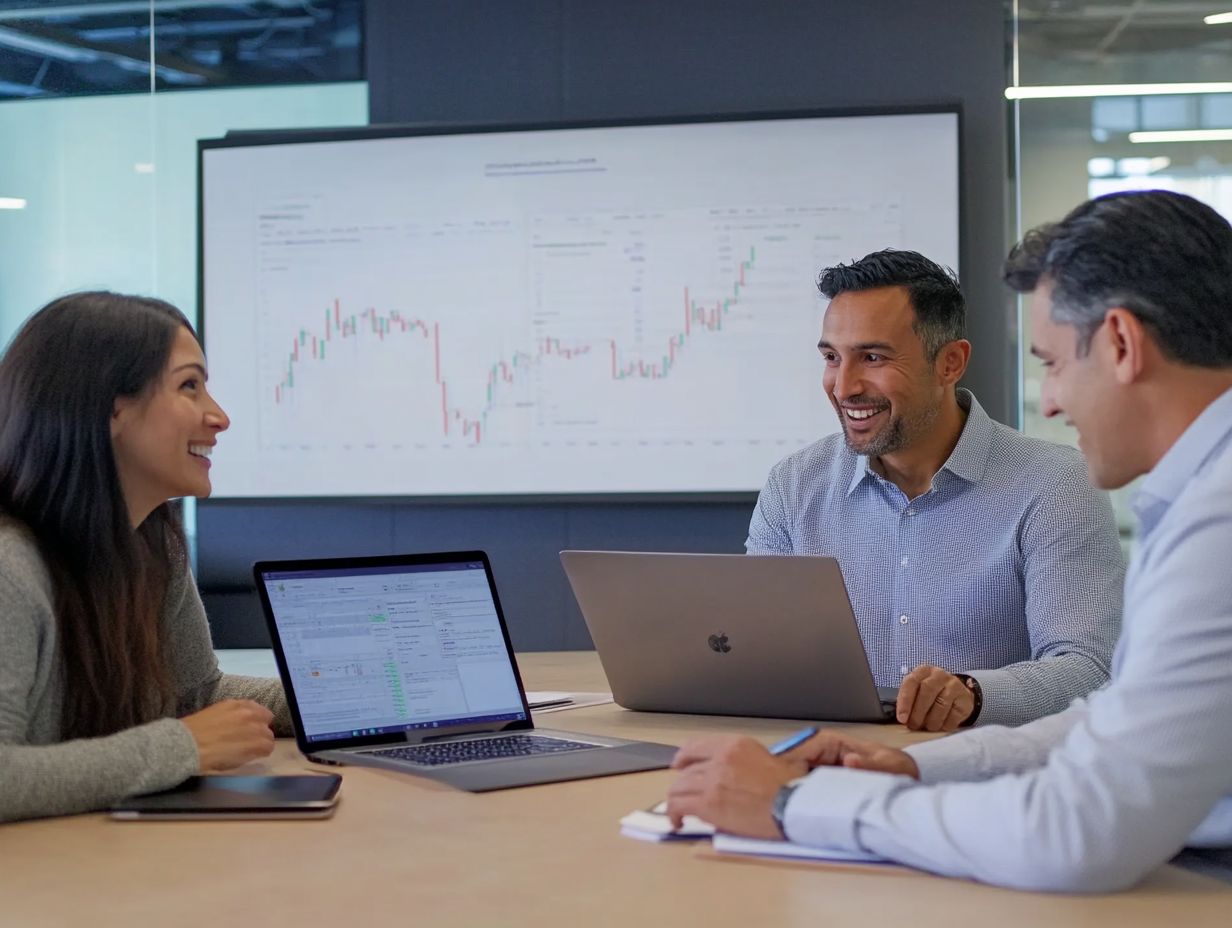How to Build a Risk-Aware Trading Culture
In the fast-paced world of trading, understanding and managing risk is absolutely crucial for your success. This article delves into the significance of risk-aware trading and how you can seamlessly weave it into your trading culture.
Key topics include establishing robust risk management policies tailored to your needs, training your traders effectively, and identifying potential risks with the help of powerful assessment tools.
You’ll find insightful strategies for mitigating those risks and ensuring that you continuously adapt to the ever-changing landscape.
Join us to discover how to cultivate a sustainable, risk-aware trading environment that promotes growth and resilience in your trading endeavors.
Contents
- Key Takeaways:
- The Importance of Risk-Aware Trading
- Creating a Risk-Aware Trading Culture
- Identifying and Assessing Risks
- Managing and Mitigating Risks
- Building a Sustainable Risk-Aware Trading Culture
- Frequently Asked Questions
- What is a risk-aware trading culture?
- Why is it important to build a risk-aware trading culture?
- What steps can a company take to build a risk-aware trading culture?
- What are some common risks in trading activities?
- How can individuals within a company contribute to a risk-aware trading culture?
- What are the benefits of a risk-aware trading culture for investors?
Key Takeaways:

- Understanding the risks involved in trading is crucial for success in the market.
- Establishing clear risk management policies and providing ongoing training can help create a risk-aware trading culture.
- Regularly identifying, assessing, and managing risks is essential for building a sustainable trading culture.
The Importance of Risk-Aware Trading
In today’s volatile financial landscape, risk-aware trading is essential. Understanding risk management principles can greatly enhance your financial performance and bolster organizational resilience.
By creating a culture that focuses on understanding risks and demonstrating strong leadership commitment, you can effectively navigate the complexities of trading while minimizing potential risks.
According to ISO 31000, integrating risk management into your organizational culture fosters a collective understanding of risks, paving the way for well-considered choices and better involvement from employees.
Understanding Risk in Trading
Understanding risk in trading means recognizing the different forms it can take, such as market volatility, liquidity risk (the risk of not being able to quickly buy or sell assets), and credit risk (the risk of counterparties failing to meet obligations), all of which can significantly impact financial institutions.
By effectively identifying and analyzing these risks, you can assess your comfort level with taking risks and make informed decisions that align with your organizational objectives.
In the trading world, market risk often manifests as price fluctuations that could lead to potential losses. For example, an unexpected economic shift might suddenly alter stock prices, leaving you scrambling. On the other hand, credit risk comes into play when counterparties fail to meet their obligations, putting the integrity of transactions at serious risk.
To tackle these challenges head-on, consider employing risk analysis techniques like scenario analysis and stress testing, which provide valuable insights into potential vulnerabilities.
Align your risk management strategies with your organizational goals, as this fosters resilience and gives you the power to adapt effectively to both anticipated and unforeseen changes in the trading landscape.
Creating a Risk-Aware Trading Culture
Building a risk-aware trading culture is key to your success! It fosters an environment where risk management is a collective responsibility shared by every employee, as detailed in how to cultivate a resilient trading environment.
Your leadership commitment is vital in weaving risk awareness into the fabric of your organizational culture. By ensuring that employees receive proper training and are engaged in effective communication and knowledge-sharing, you create a dynamic where proactive involvement flourishes.
This approach aligns with best practices in risk management and gives you the power to navigate challenges with confidence.
Establishing Risk Management Policies
Establishing robust risk management policies is essential for your organization to protect assets and ensure compliance with ISO standards, which are international guidelines that help organizations improve their processes and ensure quality, such as ISO 31000. These policies provide a framework for deploying risk tools, metrics, and practices. They enhance your ability to identify and analyze risks, while also facilitating effective governance at the board level.
Integrating these key elements will empower you to tackle risks head-on and systematically address potential vulnerabilities within operations. Utilizing well-defined risk metrics enables you to quantify threats, assess their potential impact, and prioritize responses accordingly.
An engaged board is vital for overseeing the implementation of these policies, fostering a culture of accountability and transparency. It aids in mitigating risks and supports your long-term organizational resilience and growth, positioning you to navigate uncertainties with greater agility.
Training and Education for Traders

Training and education for traders are essential for cultivating a risk-aware culture, equipping you with the skills and knowledge needed to identify and effectively mitigate risks. By embracing engaging training techniques and continuous education programs, you can deepen your understanding of risks in daily operations and risk mitigation strategies.
Implementing interactive workshops, simulation exercises, and real-time scenario analyses allows your organization to create an immersive learning environment that captivates you. These methods engage you and promote critical thinking about your real-world decisions.
Regularly updating educational content ensures that you remain informed about the latest market trends and emerging risks, ultimately enhancing your risk management strategies. This approach empowers you to make informed decisions, significantly boosting your overall trading success and confidence as you navigate the complexities of financial landscapes.
Identifying and Assessing Risks
Identifying and assessing risks is a crucial first step in the risk management process, particularly for organizations aiming to successfully navigate the complexities of trading. By utilizing effective risk identification techniques and advanced analysis tools, you can prioritize risks based on their potential impact and likelihood.
This approach ensures that critical risks are continuously monitored and addressed without delay, allowing for a proactive stance in managing uncertainties.
Tools and Techniques for Risk Assessment
Utilizing effective tools and techniques for risk assessment significantly enhances your organization’s capacity to systematically identify, analyze, and prioritize risks, ensuring they are managed efficiently. Tools like risk matrices, risk registers, and various risk analysis methods provide essential frameworks for documenting and visualizing these risks.
These tools allow you to quantify potential impacts, giving you a nuanced understanding of how different factors might influence outcomes in various trading scenarios. For instance, risk matrices enable you to visually prioritize risks based on their likelihood and severity, while risk registers track identified risks and mitigation strategies over time.
By applying these methodologies alongside risk metrics such as Value at Risk (VaR) or Conditional Value at Risk (CVaR) you can craft a robust risk management strategy. This strategy not only protects your investments but also facilitates well-considered choices amidst market volatility.
Managing and Mitigating Risks
Managing and mitigating risks demands a proactive mindset involving strategies designed to address identified risks and bolster your organization s resilience against potential operational challenges.
By fostering a collaborative environment and encouraging employee engagement, you can create a comprehensive risk-mitigation strategy that seamlessly aligns with your performance objectives.
Implementing Risk Mitigation Strategies
Implementing effective risk mitigation strategies is crucial for minimizing the impact of identified risks on financial performance and ensuring project success.
By prioritizing risks through structured communication and employing best practices in project management, you can navigate challenges more effectively and achieve your organizational objectives.
To elevate these strategies, creating a transparent environment is essential. This allows your teams to share insights and updates on potential risks.
Regular risk assessments, where you evaluate and categorize potential threats by their likelihood and impact, empower you to make informed decisions.
Using tools like risk matrices tools that help visualize the likelihood and impact of risks simplifies the visualization of risks. Establishing clear communication protocols ensures that all stakeholders are on the same page.
This blend of careful assessment and effective dialogue not only helps minimize risks but also builds trust among team members, ultimately leading to more resilient project outcomes.
Continuously Monitoring and Adapting to Risks

Continuously monitoring and adapting to risks is crucial for maintaining an effective system for managing risks that addresses the ever-evolving challenges your organization faces.
By using risk metrics and fostering a culture of knowledge-sharing and continuous education, you can remain agile in the face of new risks.
This proactive approach helps identify potential hazards and encourages team members to share insights and experiences, leading to better decisions.
Establishing regular training sessions and workshops cultivates a strong foundation of expertise, empowering individuals to learn and disseminate vital information.
By leveraging technology to track and analyze risks in real time, you can make immediate adjustments and ensure your organization stays ahead.
Ultimately, this blend of ongoing education and heightened risk awareness boosts your overall resilience, equipping your teams to handle uncertainties effectively and adapt swiftly to changes.
Building a Sustainable Risk-Aware Trading Culture
Building a sustainable, risk-aware trading culture is essential for embedding risk management principles deep within your organization. By following the best practices for risk management in trading, you can ensure these principles shine through in everyday operations.
By aligning with ISO standards and prioritizing transparent communication and employee engagement, you can foster an environment that proactively identifies and addresses risks.
This approach not only enhances resilience but also gives the power to everyone in the organization to contribute to a culture of risk awareness.
Incorporating Risk Management into Company Culture
Incorporating risk management into your company culture is essential for fostering a proactive environment where every employee recognizes their role in identifying and managing risks.
When leadership is committed to embedding these practices, it encourages involvement and creates a shared responsibility for risk outcomes.
To make this happen, leaders need to model risk-aware behavior, demonstrating how risk considerations influence decision-making.
Regular training sessions empower you with the tools and knowledge necessary to identify potential challenges in your daily tasks.
Developing a shared language around risk can bridge gaps in understanding, ensuring that each team member feels equipped to engage in risk discussions.
Cultivating an environment where feedback on risks is encouraged significantly enhances trust and collaboration among staff, ultimately leading to a more resilient organization.
This communal approach not only mitigates risks more effectively but also aligns team goals, fostering a sense of unity and shared purpose.
Evaluating and Improving Risk Management Processes
Evaluating and enhancing your risk management processes is crucial for your organization as you strive to meet performance goals while ensuring compliance with International Organization for Standardization (ISO) standards, which help ensure quality, safety, and efficiency.
By regularly assessing your risk management strategies and utilizing risk metrics, you can pinpoint areas that need improvement. This proactive stance promotes ongoing learning and strengthens your organization s resilience.
Integrating performance metrics sheds light on how effective your current strategies are. It also uncovers potential gaps that could impede optimal performance.
Next, establish continuous improvement initiatives. This cycle will yield actionable insights that refine processes and reinforce compliance. This complete approach empowers your organization to remain agile and better prepared to navigate the ever-evolving landscape of risks.
Frequently Asked Questions
What is a risk-aware trading culture?

A risk-aware trading culture is an organizational mindset that prioritizes risk management and mitigation strategies. It involves understanding and acknowledging potential risks in trading activities and taking proactive steps to minimize them.
Why is it important to build a risk-aware trading culture?
A risk-aware trading culture helps organizations prevent and manage potential losses in trading activities. It also promotes responsible trading practices, which can improve overall performance and reputation.
What steps can a company take to build a risk-aware trading culture?
Building a risk-aware trading culture requires leadership support, clear risk management policies, employee training, and a culture of open communication and accountability, as outlined in how to develop a risk management mindset.
What are some common risks in trading activities?
Common risks in trading include market volatility, regulatory changes, pricing errors, cybersecurity threats, and human error. Organizations must identify and assess these risks to effectively manage and mitigate them.
How can individuals within a company contribute to a risk-aware trading culture?
Individuals can contribute to a risk-aware trading culture by participating in risk management efforts, following policies, reporting risks, and seeking to improve their own risk awareness.
What are the benefits of a risk-aware trading culture for investors?
A risk-aware trading culture can enhance investor confidence and transparency in a company’s trading practices. This can lead to increased trust and potentially attract more investors, benefiting the organization’s overall success.






